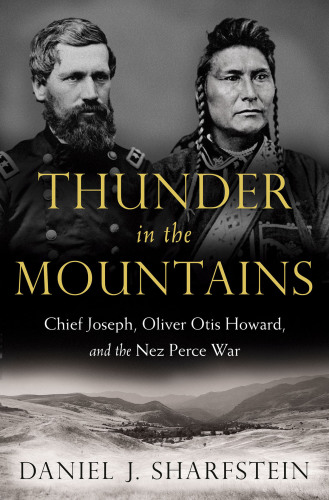
Thunder in the Mountains
Chief Joseph, Oliver Otis Howard, and the Nez Perce War
کتاب های مرتبط
- اطلاعات
- نقد و بررسی
- دیدگاه کاربران
نقد و بررسی

January 30, 2017
Revealing all the strengths and weaknesses of popular history, Sharfstein (The Invisible Line), professor of law and history at Vanderbilt University, relates the oft-told tale of Native American bravery and misguided American policy during the Nez Perce War of 1877 through the lives and exploits of two great tragic figures. Sharfstein writes with great skill and due regard for the sad, human elements of the U.S. effort to hem in and defeat a defiant people whose great leader remains an example of moral courage and bearing. No other book better brings to the fore the qualities of Chief Joseph or better explores the dilemma of his pursuer, Gen. O.O. Howard, a major personage of Reconstruction whom Joseph frustrated at every turn. Moreover, Sharfstein dug deeper into the sources than any predecessor and unearthed new dimensions of this particular history. This is in many ways a splendid book. But it’s also a bloated one, filled with irrelevant details—the speed of a train, what people packed to travel—and yet inexcusably lacking any maps. It’s also just a story, and no matter how well told it is, it reveals nothing of the place of the Nez Perce War in the larger scheme of American colonizers’ efforts to suppress native independence.

Starred review from February 15, 2017
A chronicle of the white conquest of the inland Northwest at the expense of native peoples defeated in a war that even the newcomers recognized to be unjust.Oliver Otis Howard enjoyed mixed success--but mostly failure, it seems--as an officer in the Army. At Gettysburg, his command suffered such heavy losses that he was summarily replaced by a junior officer, which, recounts Sharfstein (Law and History/Vanderbilt Univ.; The Invisible Line: Three American Families and the Secret Journey from Black to White, 2011), left him "mortified." A leading agent of Reconstruction, Howard failed to avert Jim Crow. He was unwanted during the Spanish-American War, but he haunted the military camps as a kind of evangelical candy striper. In between, he commanded a badly conducted campaign against the Nez Perce Indians of the Northwest, led by a man named Chief Joseph, who, though not a war chief, had plenty of experience tangling with white invaders. Sharfstein looks at that well-studied campaign in light of those framing events, seeing westward expansion and the Indian Wars as a continuation of the nation's growing militarism, which closed off the century with war against Spain. The author contrasts Howard, a sometimes-competent, often self-doubtful man, with one of his junior officers, who went from fighting the Nez Perce in a savage war--as Sharfstein writes, "there was nothing abstract about the dead," scalped, mutilated, and blackened in the hot sun--to becoming a fierce critic of American imperialism. Even there, notes the author, the oppositional argument was tainted with social Darwinist ideas, warning against "the dangers of absorbing 'an Asiatic population of mixed blood, ' millions of 'yellow, naked mongrels' and coolie laborers." Mixed with exciting set pieces--battles, treaty negotiations, oratory over whose rightful land it was--and bolstered by impressive archival research, Sharfstein's story unfolds as a swift-moving narrative of tragic inevitability. A superb, densely detailed complement to William Vollmann's poetic/fictional treatment The Dying Grass (2015), of compelling interest to any student of 19th-century American history.
COPYRIGHT(2017) Kirkus Reviews, ALL RIGHTS RESERVED.

Starred review from February 15, 2017
Sharfstein (law, history, Vanderbilt Univ.; The Invisible Line) examines the causes and consequences of the Nez Perce War of 1877, using the intertwined stories of Gen. Oliver O. Howard (1830-1909) and Chief Joseph (1840-1904) to frame this thoroughly researched work. The author places this confrontation between Native peoples and white settlers within the context of broader events of the 19th century. Howard, a tireless champion of freed slaves, was tasked with convincing the Nez Perce to move onto reservations assigned to them by a series of treaties. When tensions flared, Joseph and Howard attempted to resolve the conflict, first peacefully and eventually through war. Sharfstein provides considerable detail about skilled and heroic Nez Perce fighters and families, who bested Howard's larger forces at many turns before their final defeat. The story is filled with considerable irony, as men seeking a peaceful resolution were drawn into deadly conflict. Among the many extraordinary stories here is that of C.E.S. Wood, whose participation in this war eventually led him to a life devoted to helping the disadvantaged. VERDICT Highly recommended for general readers as well as those interested in the history of Native peoples. [See Prepub Alert, 10/17/16.]--Charles K. Piehl, Minnesota State Univ., Mankato
Copyright 2017 Library Journal, LLC Used with permission.

























دیدگاه کاربران